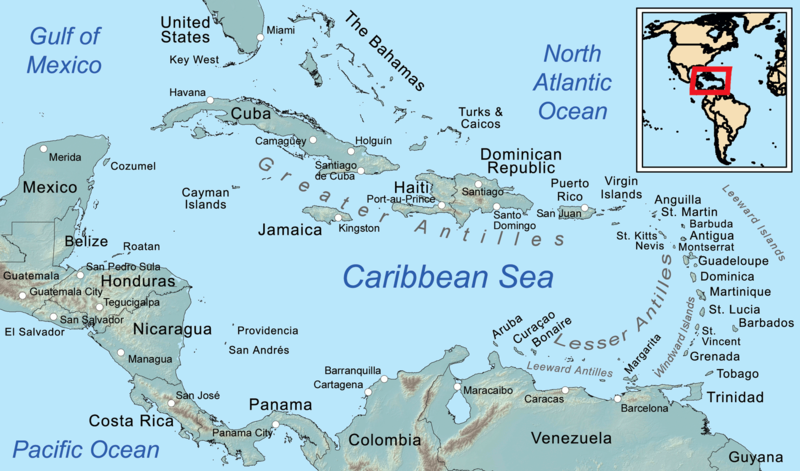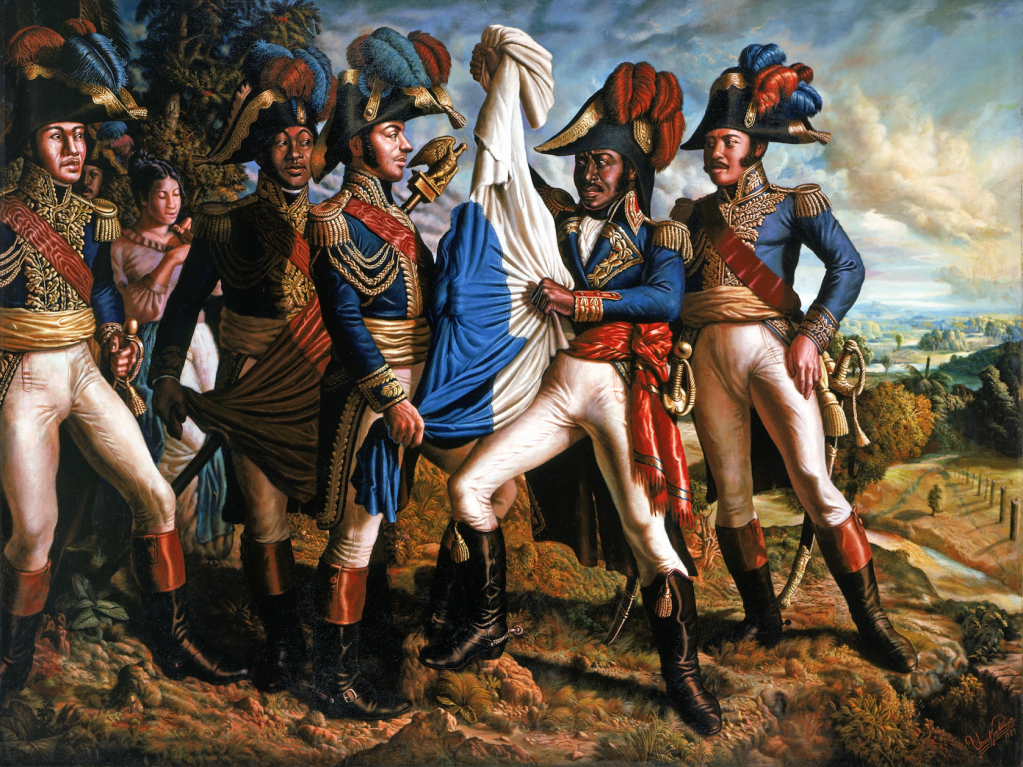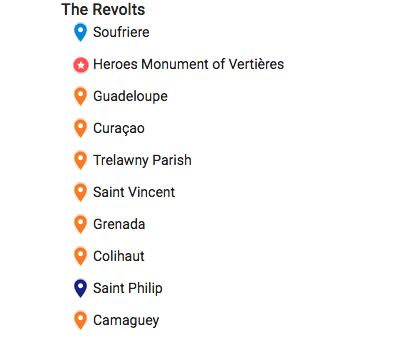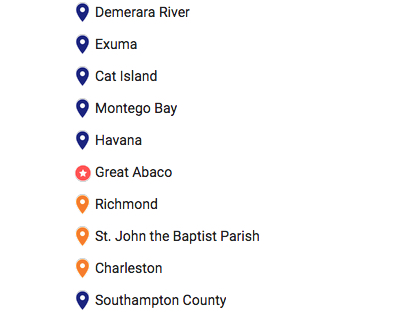
The Ships That Set Sail
An Introduction to Imperial Invasion
The Legacy of Revolution
“For Africa to me… is more than a glamorous fact. It is a historical truth. No man can know where he is going unless he knows exactly where he has been and exactly how he arrived at his present place.”
MAYA Angelou
The Voyage of Water, Fire & Ash
The Timeline

With this project, I set out to explore the intersections of the African Diaspora and emphasize the role of Caribbean Slave Revolts in impacting not just the American abolitionist movement but also International abolition. In doing so, I gained enlightenment beyond my wildest dreams regarding the intersections and the similarities of fights for freedom within the African Diaspora. The history of every area inspired me. The tenacity of the early Maroon societies in Suriname, Jamaica, Antigua, and Dominica amazed me. The Haitian Revolution proved legendarily impactful as it provided the first black republic awakening imperial powers and abused slaves to the possibilities of rebellion. The African Ancestors who walked the Caribbean, Americas, Africa, and Europe all possessed an agency and resilience, which society and European narratives often omit from their stories.
(Artwork By: Paul Campbell, Fervent Hope. 2017.)
Parting the Caribbean Sea
— The Game of Empires—
The transfer of power (from indigenous peoples to colonial invaders and back again) in the Caribbean portion of the Atlantic World, aka “The Game of Empires: Caribbean Edition can become a bit complicated. Many islands traded many hands as Spain’s unprecedented rule came to an end in the sixteenth century. The purpose of colonization and the utility of colonies differed among the various powers. The main reasons were expansion and settlement, profit and production, and lastly, trade. A modern map of the Caribbean shown below makes it easier to understand the spread of the Imperial powers throughout the region. With the increasing popularity of European exploration resulting from Spain’s success with Cuba and Hispaniola (sugar), many other European powers desired to stake their claim on the scenic (and hopefully profitable) islands. In 1542 the encomienda system and indigenous slavery were abolished under new laws of the Indies issued by the Spanish crown, making African slavery more prevalent and necessary. Additionally, it bolstered the Black populations on many islands making Black people the majority in the face of few white overseers and settlers. Overseers, immigrants, and especially absentee plantation owners wanted a profit. More slaves equated to more gain.

The Chains that Crossed the Ocean
— The Establishment of Plantations —
The cultivation of different cash crops and labor methods required created different environments, population demographics, and regional labor experiences for enslaved Africans brought to the West Indies. Sugar’s profit potential spurred the rise of plantations across the world, from the Middle East to the Mediterranean to the islands in the Atlantic and the Indian Ocean near Africa and the Americas. European settlers quickly established plantation systems in the West Indies that would dominate the trans-Atlantic sugar market. Still, large amounts of strenuous physical labor were required to sustain the Sugar agriculture and produce a lucrative export of the crop. Sugar also required laborers to be skilled in processing the sugarcane to juice and then crystallizing sugar, alcohol, or molasses. The multi-faceted nature of the product and the potential gain spurred the European settlers to scramble for workers. Initially, the work was done by enslaved American Indians, European indentured servants, and enslaved Africans. However, following the decimation of Indigenous populations by European diseases and the reluctance and refusal of indentured servants to endure the brutal conditions of sugar plantations, African slavery became the dominant system of labor on the plantations.

The Swelling of the Tide
Caribbean Slave Revolts (1649-1790)
I decided to make the anchoring case studies of my paper, the Haitian Revolution, and the Creole Case of 1841. This selection is due to the Haitian Revolution’s incendiary effect on other West Indian colonies and their overseers. Further, the revolution brought global attention to the gross injustices and immorality of the system of slavery and the lengths that slaves would take to escape. These revelations induced a new conviction for abolition. The Creole Case shows the extent of this conviction and the endless pursuit of freedom sought by those unbreakable souls that were stolen and longed to obtain autonomy. These two significant events that connect the African Diaspora show the intricate threads that bind all of its members irrevocably. Finally, all three corners of black existence, African, Caribbean, and African American, have neatly folded into their own stories, their edges grazing and magically falling into place to create a perfect image. They all have value. They all hold a wealth of information regarding the origins of practices, customs, and beliefs alive in their respective cultures and countries.
The Colonial Spark of Haiti

The Little Fires Everywhere


Freedom’s Shores
The Creole case added more momentum to the steam of American abolitionism, creating a sense of introspection and ideological exposure which further divided its citizens. This case is hugely important for this reason as it aided the change of the system of slavery. The Creole Case also greatly influenced black abolitionists who heard the story of the slaves who’d arrived at Freedom’s Shores. It gave them renewed energy to fight against the institution of slavery, the trade and lobby for emancipation. The event became so popular that Frederick Douglass published a story inspired by it entitled The Heroic Slave which featured Washington. Douglass remarked that the rebellion was a pivotal component of American revolutionary tradition and history.

In 1803 Jean-Jacques Dessalines created the Haitian flag as a marker of the country’s independence, representing a beacon of hope as it was the first free black nation in the world. The colors of the flag were representative of the joint resistance of Blacks and Mulattoes. Feeling their imminent defeat, the French troops withdrew in August of 1803, and on January 1 of 1804, Dessalines abolished slavery in the colony and published the Declaration of Independence.
To cement their independence and freedom, they renamed the settlement Hayti which was the original name given to the island by the indigenous Tainos. In doing this name change, they cemented their distance from France.With the colonial spark igniting the Caribbean freedom fight, the flames of the Haitian Revolution carried on to neighboring islands, creating problems for other Imperial powers within the West Indies as little fires erupted everywhere. The slaves of the West Indies became alighted at the prospect of equality and saw freedom on the horizon. The flame that Haiti had sparked shone so brightly that it inspired similar revolts throughout the West Indies. Some examples of these revolts occurred in Grenada, Curacao, St. Lucia, Jamaica, Colombia, and Venezuela. In addition to this, it also struck fear in plantation owners’ hearts petrified at the thought of another Haiti forming.



The Library Company of Philadelphia
The Ancestors & The Ashes

From Haiti’s flames, which paved the way, our ancestors fought for freedom as imperial powers tried to oust the little fires spreading everywhere. The above painting created by Calvert Jones displays a conversation about resistance between notable revolutionary and historical black figures. From left to right Elijah Muhammed, Bob Marley, Jean-Jaques Dessaline, Marcus Garvey, King Court Takey (Prince Klaas), Harriet Tubman, Joseph Chatoyer, Simon Bolivar, Dr Eric Williams, Paul Bogle and Louis Farrakhan can be seen while Jesus is pictured in the middle of them all with a sword in his hand and a bible in the other. To me this represents the sanctity of freedom and the divine need to pursue it through peace or battle.
Africa serves as the foundation of all cultures, the trunk from which all ancestors came, and the different ethnicities of the diaspora branch from it, blooming when the other blooms and sharing resources for survival. When imperial powers sought to burn the trunk, the fire spread throughout the entire tree, but our ancestors rose from the ashes. They fought and were burned, battered, bruised, and victorious. When their ashes scattered, it paved the way to freedom for their descendants, granting the generational gift of autonomy instead of the generational curse of slavery.
The Descendants
“A people without knowledge of their past history, origin and culture is like a tree without roots.”
Marcus Garvey